Comprehensive Assignment: Birth Control, Population, and London's CBD
VerifiedAdded on 2023/01/18
|9
|2275
|72
Homework Assignment
AI Summary
This assignment delves into several interconnected public health and urban planning topics. It begins with an exploration of birth control methods, including hormonal, barrier, and behavioral methods, emphasizing the role of family planning and government initiatives like voluntary sterilization and emergency contraception in controlling birth rates and reducing maternal deaths. The assignment then shifts to population structure, examining the factors influencing Japan's changing demographics, such as declining fertility rates, aging populations, and cultural/economic influences, alongside the impacts of government policies. The demographic model is then applied to Japan's population trends, charting its progression through different stages and the associated changes in birth and death rates. Finally, the assignment analyzes the urban structure of London, focusing on the Central Business District (CBD) and its functions, transportation systems, and the impact of tourism. It explores how transport systems in London's CBD can be improved and the negative environmental effects of tourism, including resource depletion and pollution. The assignment concludes by highlighting the importance of sustainable practices in the tourism industry. The assignment draws on research from several sources, including studies on the effectiveness of birth control methods, demographic changes in Japan, and the impacts of tourism.

Running head: ASSIGNMENTS 1
Assignments
Name
Institution
Assignments
Name
Institution
Paraphrase This Document
Need a fresh take? Get an instant paraphrase of this document with our AI Paraphraser
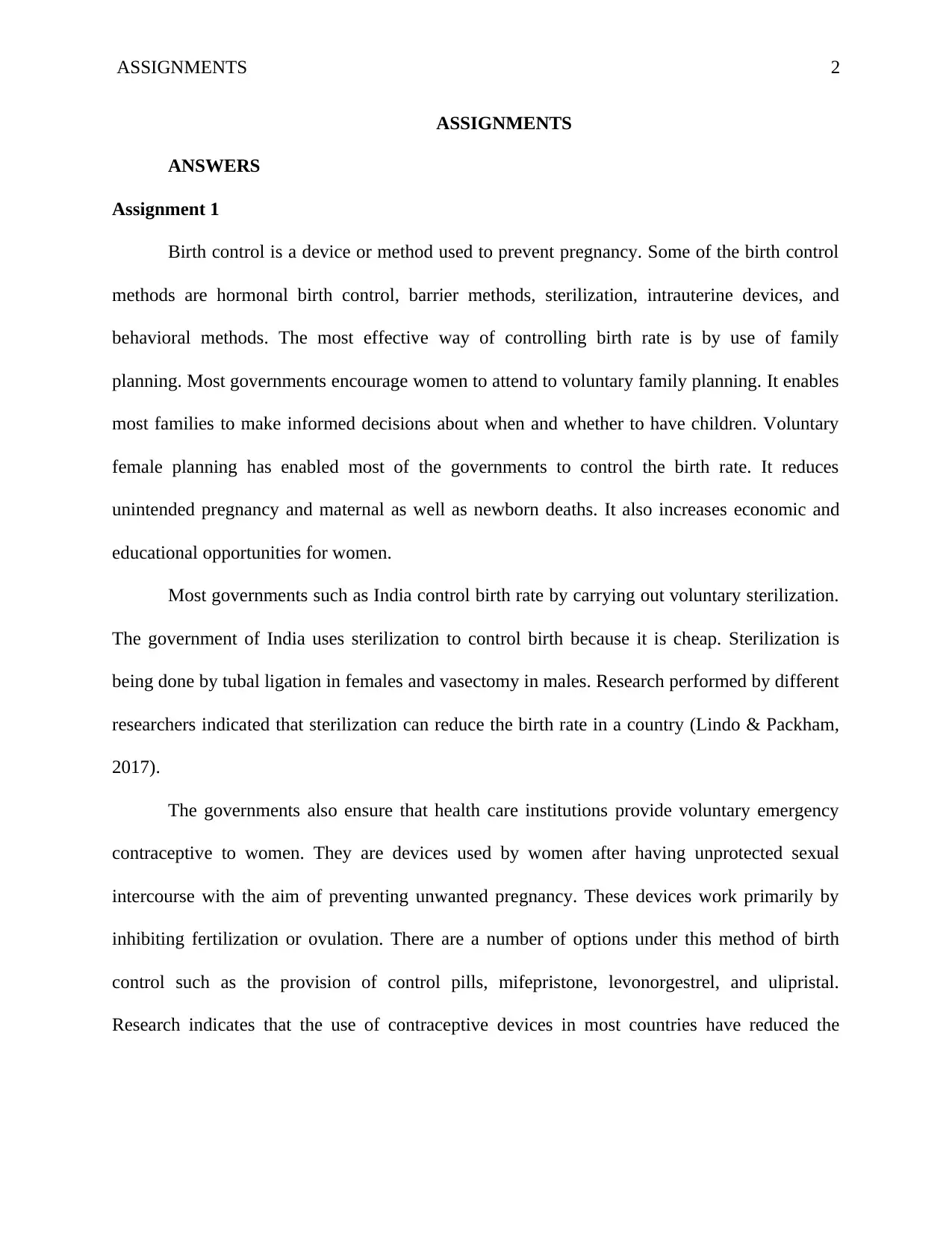
ASSIGNMENTS 2
ASSIGNMENTS
ANSWERS
Assignment 1
Birth control is a device or method used to prevent pregnancy. Some of the birth control
methods are hormonal birth control, barrier methods, sterilization, intrauterine devices, and
behavioral methods. The most effective way of controlling birth rate is by use of family
planning. Most governments encourage women to attend to voluntary family planning. It enables
most families to make informed decisions about when and whether to have children. Voluntary
female planning has enabled most of the governments to control the birth rate. It reduces
unintended pregnancy and maternal as well as newborn deaths. It also increases economic and
educational opportunities for women.
Most governments such as India control birth rate by carrying out voluntary sterilization.
The government of India uses sterilization to control birth because it is cheap. Sterilization is
being done by tubal ligation in females and vasectomy in males. Research performed by different
researchers indicated that sterilization can reduce the birth rate in a country (Lindo & Packham,
2017).
The governments also ensure that health care institutions provide voluntary emergency
contraceptive to women. They are devices used by women after having unprotected sexual
intercourse with the aim of preventing unwanted pregnancy. These devices work primarily by
inhibiting fertilization or ovulation. There are a number of options under this method of birth
control such as the provision of control pills, mifepristone, levonorgestrel, and ulipristal.
Research indicates that the use of contraceptive devices in most countries have reduced the
ASSIGNMENTS
ANSWERS
Assignment 1
Birth control is a device or method used to prevent pregnancy. Some of the birth control
methods are hormonal birth control, barrier methods, sterilization, intrauterine devices, and
behavioral methods. The most effective way of controlling birth rate is by use of family
planning. Most governments encourage women to attend to voluntary family planning. It enables
most families to make informed decisions about when and whether to have children. Voluntary
female planning has enabled most of the governments to control the birth rate. It reduces
unintended pregnancy and maternal as well as newborn deaths. It also increases economic and
educational opportunities for women.
Most governments such as India control birth rate by carrying out voluntary sterilization.
The government of India uses sterilization to control birth because it is cheap. Sterilization is
being done by tubal ligation in females and vasectomy in males. Research performed by different
researchers indicated that sterilization can reduce the birth rate in a country (Lindo & Packham,
2017).
The governments also ensure that health care institutions provide voluntary emergency
contraceptive to women. They are devices used by women after having unprotected sexual
intercourse with the aim of preventing unwanted pregnancy. These devices work primarily by
inhibiting fertilization or ovulation. There are a number of options under this method of birth
control such as the provision of control pills, mifepristone, levonorgestrel, and ulipristal.
Research indicates that the use of contraceptive devices in most countries have reduced the
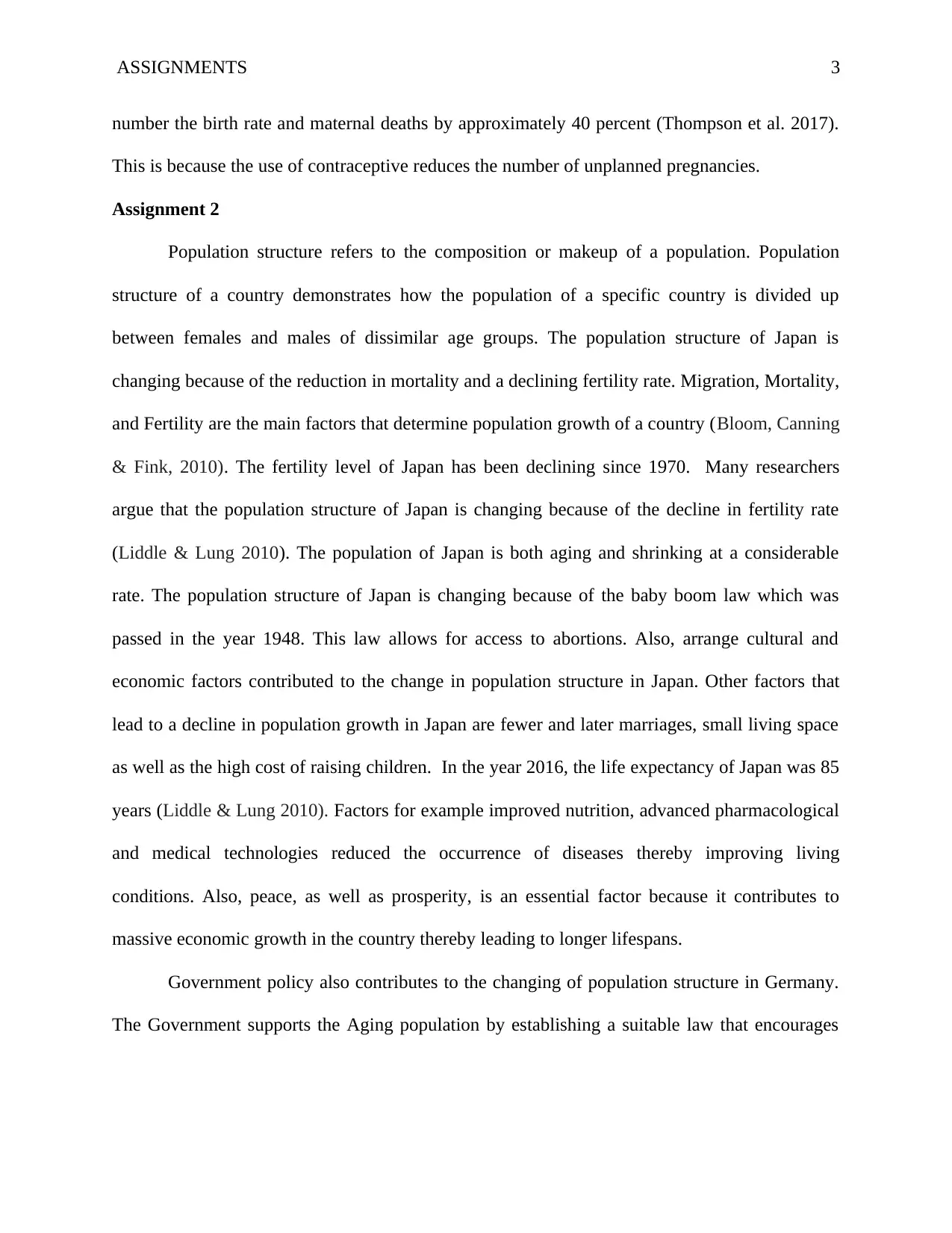
ASSIGNMENTS 3
number the birth rate and maternal deaths by approximately 40 percent (Thompson et al. 2017).
This is because the use of contraceptive reduces the number of unplanned pregnancies.
Assignment 2
Population structure refers to the composition or makeup of a population. Population
structure of a country demonstrates how the population of a specific country is divided up
between females and males of dissimilar age groups. The population structure of Japan is
changing because of the reduction in mortality and a declining fertility rate. Migration, Mortality,
and Fertility are the main factors that determine population growth of a country (Bloom, Canning
& Fink, 2010). The fertility level of Japan has been declining since 1970. Many researchers
argue that the population structure of Japan is changing because of the decline in fertility rate
(Liddle & Lung 2010). The population of Japan is both aging and shrinking at a considerable
rate. The population structure of Japan is changing because of the baby boom law which was
passed in the year 1948. This law allows for access to abortions. Also, arrange cultural and
economic factors contributed to the change in population structure in Japan. Other factors that
lead to a decline in population growth in Japan are fewer and later marriages, small living space
as well as the high cost of raising children. In the year 2016, the life expectancy of Japan was 85
years (Liddle & Lung 2010). Factors for example improved nutrition, advanced pharmacological
and medical technologies reduced the occurrence of diseases thereby improving living
conditions. Also, peace, as well as prosperity, is an essential factor because it contributes to
massive economic growth in the country thereby leading to longer lifespans.
Government policy also contributes to the changing of population structure in Germany.
The Government supports the Aging population by establishing a suitable law that encourages
number the birth rate and maternal deaths by approximately 40 percent (Thompson et al. 2017).
This is because the use of contraceptive reduces the number of unplanned pregnancies.
Assignment 2
Population structure refers to the composition or makeup of a population. Population
structure of a country demonstrates how the population of a specific country is divided up
between females and males of dissimilar age groups. The population structure of Japan is
changing because of the reduction in mortality and a declining fertility rate. Migration, Mortality,
and Fertility are the main factors that determine population growth of a country (Bloom, Canning
& Fink, 2010). The fertility level of Japan has been declining since 1970. Many researchers
argue that the population structure of Japan is changing because of the decline in fertility rate
(Liddle & Lung 2010). The population of Japan is both aging and shrinking at a considerable
rate. The population structure of Japan is changing because of the baby boom law which was
passed in the year 1948. This law allows for access to abortions. Also, arrange cultural and
economic factors contributed to the change in population structure in Japan. Other factors that
lead to a decline in population growth in Japan are fewer and later marriages, small living space
as well as the high cost of raising children. In the year 2016, the life expectancy of Japan was 85
years (Liddle & Lung 2010). Factors for example improved nutrition, advanced pharmacological
and medical technologies reduced the occurrence of diseases thereby improving living
conditions. Also, peace, as well as prosperity, is an essential factor because it contributes to
massive economic growth in the country thereby leading to longer lifespans.
Government policy also contributes to the changing of population structure in Germany.
The Government supports the Aging population by establishing a suitable law that encourages
⊘ This is a preview!⊘
Do you want full access?
Subscribe today to unlock all pages.

Trusted by 1+ million students worldwide
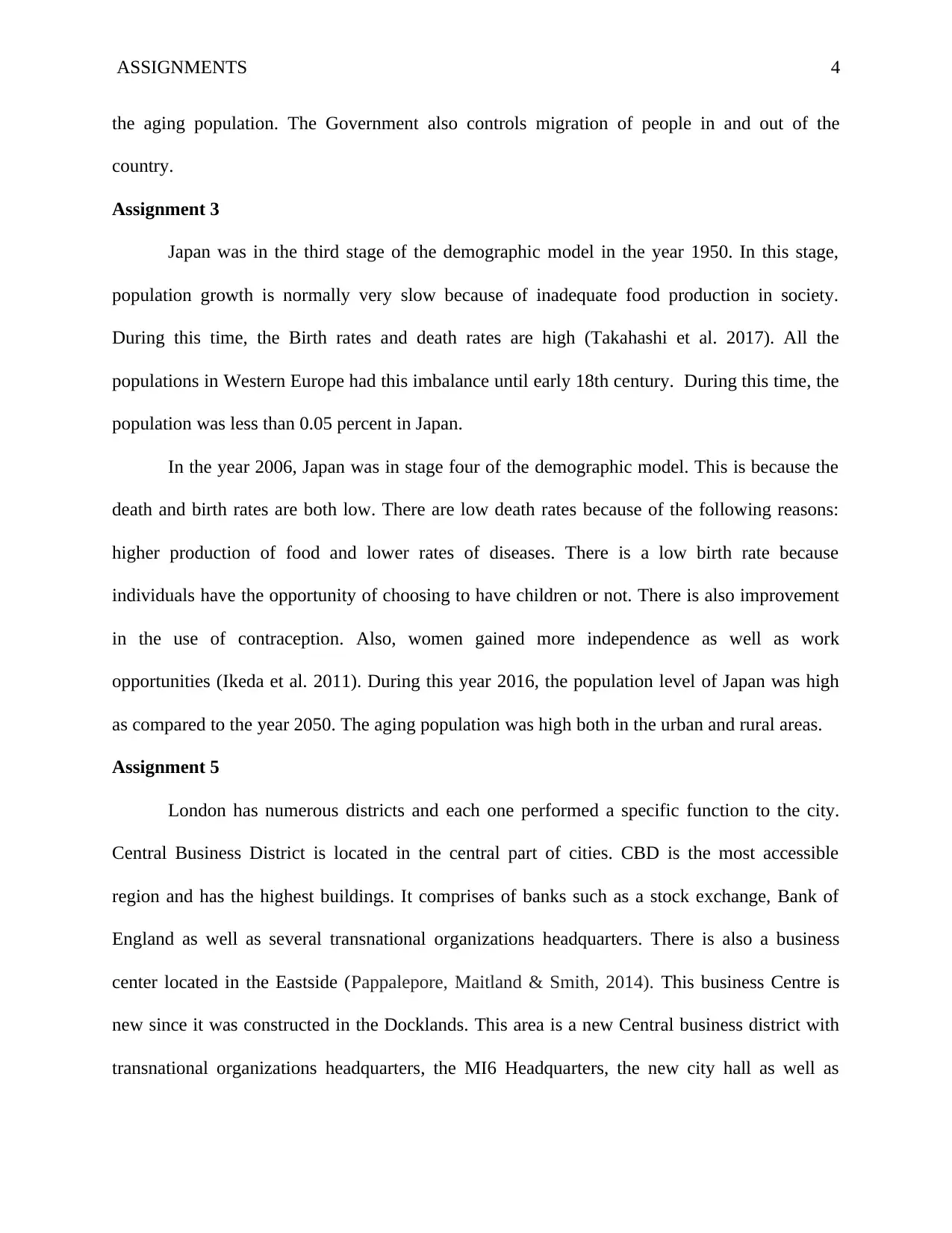
ASSIGNMENTS 4
the aging population. The Government also controls migration of people in and out of the
country.
Assignment 3
Japan was in the third stage of the demographic model in the year 1950. In this stage,
population growth is normally very slow because of inadequate food production in society.
During this time, the Birth rates and death rates are high (Takahashi et al. 2017). All the
populations in Western Europe had this imbalance until early 18th century. During this time, the
population was less than 0.05 percent in Japan.
In the year 2006, Japan was in stage four of the demographic model. This is because the
death and birth rates are both low. There are low death rates because of the following reasons:
higher production of food and lower rates of diseases. There is a low birth rate because
individuals have the opportunity of choosing to have children or not. There is also improvement
in the use of contraception. Also, women gained more independence as well as work
opportunities (Ikeda et al. 2011). During this year 2016, the population level of Japan was high
as compared to the year 2050. The aging population was high both in the urban and rural areas.
Assignment 5
London has numerous districts and each one performed a specific function to the city.
Central Business District is located in the central part of cities. CBD is the most accessible
region and has the highest buildings. It comprises of banks such as a stock exchange, Bank of
England as well as several transnational organizations headquarters. There is also a business
center located in the Eastside (Pappalepore, Maitland & Smith, 2014). This business Centre is
new since it was constructed in the Docklands. This area is a new Central business district with
transnational organizations headquarters, the MI6 Headquarters, the new city hall as well as
the aging population. The Government also controls migration of people in and out of the
country.
Assignment 3
Japan was in the third stage of the demographic model in the year 1950. In this stage,
population growth is normally very slow because of inadequate food production in society.
During this time, the Birth rates and death rates are high (Takahashi et al. 2017). All the
populations in Western Europe had this imbalance until early 18th century. During this time, the
population was less than 0.05 percent in Japan.
In the year 2006, Japan was in stage four of the demographic model. This is because the
death and birth rates are both low. There are low death rates because of the following reasons:
higher production of food and lower rates of diseases. There is a low birth rate because
individuals have the opportunity of choosing to have children or not. There is also improvement
in the use of contraception. Also, women gained more independence as well as work
opportunities (Ikeda et al. 2011). During this year 2016, the population level of Japan was high
as compared to the year 2050. The aging population was high both in the urban and rural areas.
Assignment 5
London has numerous districts and each one performed a specific function to the city.
Central Business District is located in the central part of cities. CBD is the most accessible
region and has the highest buildings. It comprises of banks such as a stock exchange, Bank of
England as well as several transnational organizations headquarters. There is also a business
center located in the Eastside (Pappalepore, Maitland & Smith, 2014). This business Centre is
new since it was constructed in the Docklands. This area is a new Central business district with
transnational organizations headquarters, the MI6 Headquarters, the new city hall as well as
Paraphrase This Document
Need a fresh take? Get an instant paraphrase of this document with our AI Paraphraser
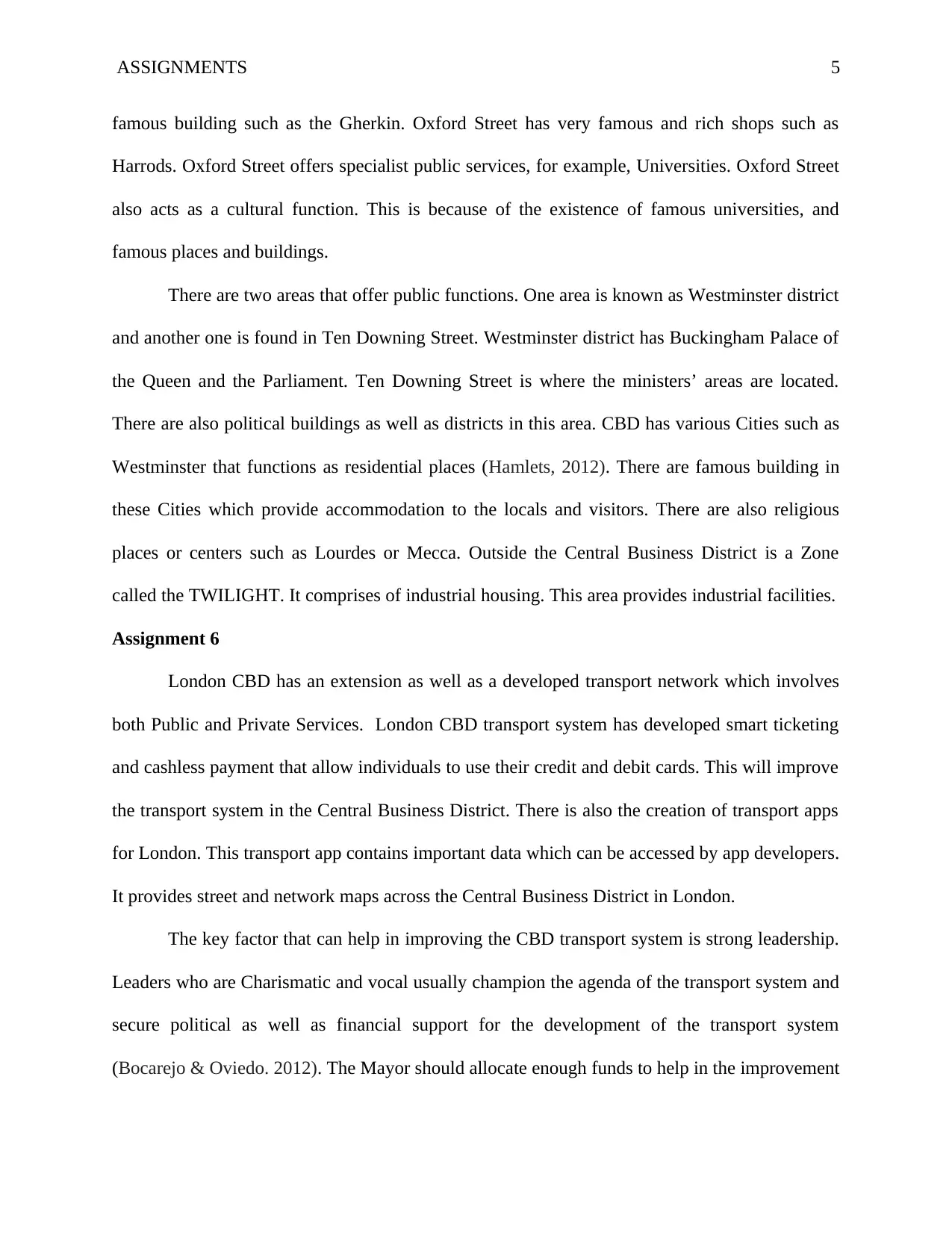
ASSIGNMENTS 5
famous building such as the Gherkin. Oxford Street has very famous and rich shops such as
Harrods. Oxford Street offers specialist public services, for example, Universities. Oxford Street
also acts as a cultural function. This is because of the existence of famous universities, and
famous places and buildings.
There are two areas that offer public functions. One area is known as Westminster district
and another one is found in Ten Downing Street. Westminster district has Buckingham Palace of
the Queen and the Parliament. Ten Downing Street is where the ministers’ areas are located.
There are also political buildings as well as districts in this area. CBD has various Cities such as
Westminster that functions as residential places (Hamlets, 2012). There are famous building in
these Cities which provide accommodation to the locals and visitors. There are also religious
places or centers such as Lourdes or Mecca. Outside the Central Business District is a Zone
called the TWILIGHT. It comprises of industrial housing. This area provides industrial facilities.
Assignment 6
London CBD has an extension as well as a developed transport network which involves
both Public and Private Services. London CBD transport system has developed smart ticketing
and cashless payment that allow individuals to use their credit and debit cards. This will improve
the transport system in the Central Business District. There is also the creation of transport apps
for London. This transport app contains important data which can be accessed by app developers.
It provides street and network maps across the Central Business District in London.
The key factor that can help in improving the CBD transport system is strong leadership.
Leaders who are Charismatic and vocal usually champion the agenda of the transport system and
secure political as well as financial support for the development of the transport system
(Bocarejo & Oviedo. 2012). The Mayor should allocate enough funds to help in the improvement
famous building such as the Gherkin. Oxford Street has very famous and rich shops such as
Harrods. Oxford Street offers specialist public services, for example, Universities. Oxford Street
also acts as a cultural function. This is because of the existence of famous universities, and
famous places and buildings.
There are two areas that offer public functions. One area is known as Westminster district
and another one is found in Ten Downing Street. Westminster district has Buckingham Palace of
the Queen and the Parliament. Ten Downing Street is where the ministers’ areas are located.
There are also political buildings as well as districts in this area. CBD has various Cities such as
Westminster that functions as residential places (Hamlets, 2012). There are famous building in
these Cities which provide accommodation to the locals and visitors. There are also religious
places or centers such as Lourdes or Mecca. Outside the Central Business District is a Zone
called the TWILIGHT. It comprises of industrial housing. This area provides industrial facilities.
Assignment 6
London CBD has an extension as well as a developed transport network which involves
both Public and Private Services. London CBD transport system has developed smart ticketing
and cashless payment that allow individuals to use their credit and debit cards. This will improve
the transport system in the Central Business District. There is also the creation of transport apps
for London. This transport app contains important data which can be accessed by app developers.
It provides street and network maps across the Central Business District in London.
The key factor that can help in improving the CBD transport system is strong leadership.
Leaders who are Charismatic and vocal usually champion the agenda of the transport system and
secure political as well as financial support for the development of the transport system
(Bocarejo & Oviedo. 2012). The Mayor should allocate enough funds to help in the improvement
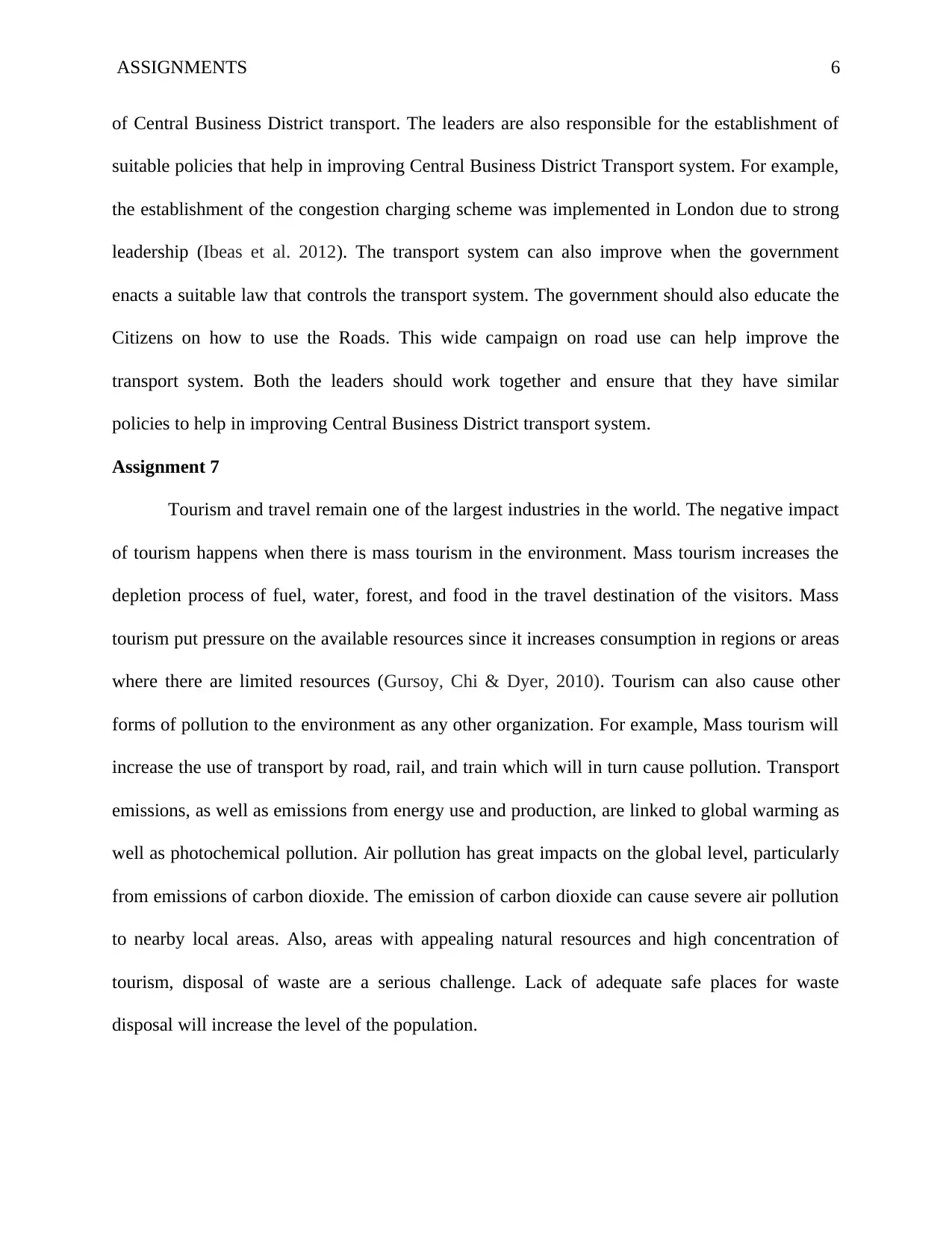
ASSIGNMENTS 6
of Central Business District transport. The leaders are also responsible for the establishment of
suitable policies that help in improving Central Business District Transport system. For example,
the establishment of the congestion charging scheme was implemented in London due to strong
leadership (Ibeas et al. 2012). The transport system can also improve when the government
enacts a suitable law that controls the transport system. The government should also educate the
Citizens on how to use the Roads. This wide campaign on road use can help improve the
transport system. Both the leaders should work together and ensure that they have similar
policies to help in improving Central Business District transport system.
Assignment 7
Tourism and travel remain one of the largest industries in the world. The negative impact
of tourism happens when there is mass tourism in the environment. Mass tourism increases the
depletion process of fuel, water, forest, and food in the travel destination of the visitors. Mass
tourism put pressure on the available resources since it increases consumption in regions or areas
where there are limited resources (Gursoy, Chi & Dyer, 2010). Tourism can also cause other
forms of pollution to the environment as any other organization. For example, Mass tourism will
increase the use of transport by road, rail, and train which will in turn cause pollution. Transport
emissions, as well as emissions from energy use and production, are linked to global warming as
well as photochemical pollution. Air pollution has great impacts on the global level, particularly
from emissions of carbon dioxide. The emission of carbon dioxide can cause severe air pollution
to nearby local areas. Also, areas with appealing natural resources and high concentration of
tourism, disposal of waste are a serious challenge. Lack of adequate safe places for waste
disposal will increase the level of the population.
of Central Business District transport. The leaders are also responsible for the establishment of
suitable policies that help in improving Central Business District Transport system. For example,
the establishment of the congestion charging scheme was implemented in London due to strong
leadership (Ibeas et al. 2012). The transport system can also improve when the government
enacts a suitable law that controls the transport system. The government should also educate the
Citizens on how to use the Roads. This wide campaign on road use can help improve the
transport system. Both the leaders should work together and ensure that they have similar
policies to help in improving Central Business District transport system.
Assignment 7
Tourism and travel remain one of the largest industries in the world. The negative impact
of tourism happens when there is mass tourism in the environment. Mass tourism increases the
depletion process of fuel, water, forest, and food in the travel destination of the visitors. Mass
tourism put pressure on the available resources since it increases consumption in regions or areas
where there are limited resources (Gursoy, Chi & Dyer, 2010). Tourism can also cause other
forms of pollution to the environment as any other organization. For example, Mass tourism will
increase the use of transport by road, rail, and train which will in turn cause pollution. Transport
emissions, as well as emissions from energy use and production, are linked to global warming as
well as photochemical pollution. Air pollution has great impacts on the global level, particularly
from emissions of carbon dioxide. The emission of carbon dioxide can cause severe air pollution
to nearby local areas. Also, areas with appealing natural resources and high concentration of
tourism, disposal of waste are a serious challenge. Lack of adequate safe places for waste
disposal will increase the level of the population.
⊘ This is a preview!⊘
Do you want full access?
Subscribe today to unlock all pages.

Trusted by 1+ million students worldwide

ASSIGNMENTS 7
Water is one of the essential natural resources. The tourism sector usually overuses water
resources for swimming pools, hotels, and golf courses (Amuquandoh, 2010). This can lead to a
shortage of water as well as the degradation of water supplies. Also, essential land resources
such as fossil fuels, forest, minerals, fertile soil, wildlife, and wetland will be affected by Mass
tourism due to the construction of recreational facilities in these areas. The increased
construction of tourism in these areas will increase pressure on the available resources.
Water is one of the essential natural resources. The tourism sector usually overuses water
resources for swimming pools, hotels, and golf courses (Amuquandoh, 2010). This can lead to a
shortage of water as well as the degradation of water supplies. Also, essential land resources
such as fossil fuels, forest, minerals, fertile soil, wildlife, and wetland will be affected by Mass
tourism due to the construction of recreational facilities in these areas. The increased
construction of tourism in these areas will increase pressure on the available resources.
Paraphrase This Document
Need a fresh take? Get an instant paraphrase of this document with our AI Paraphraser
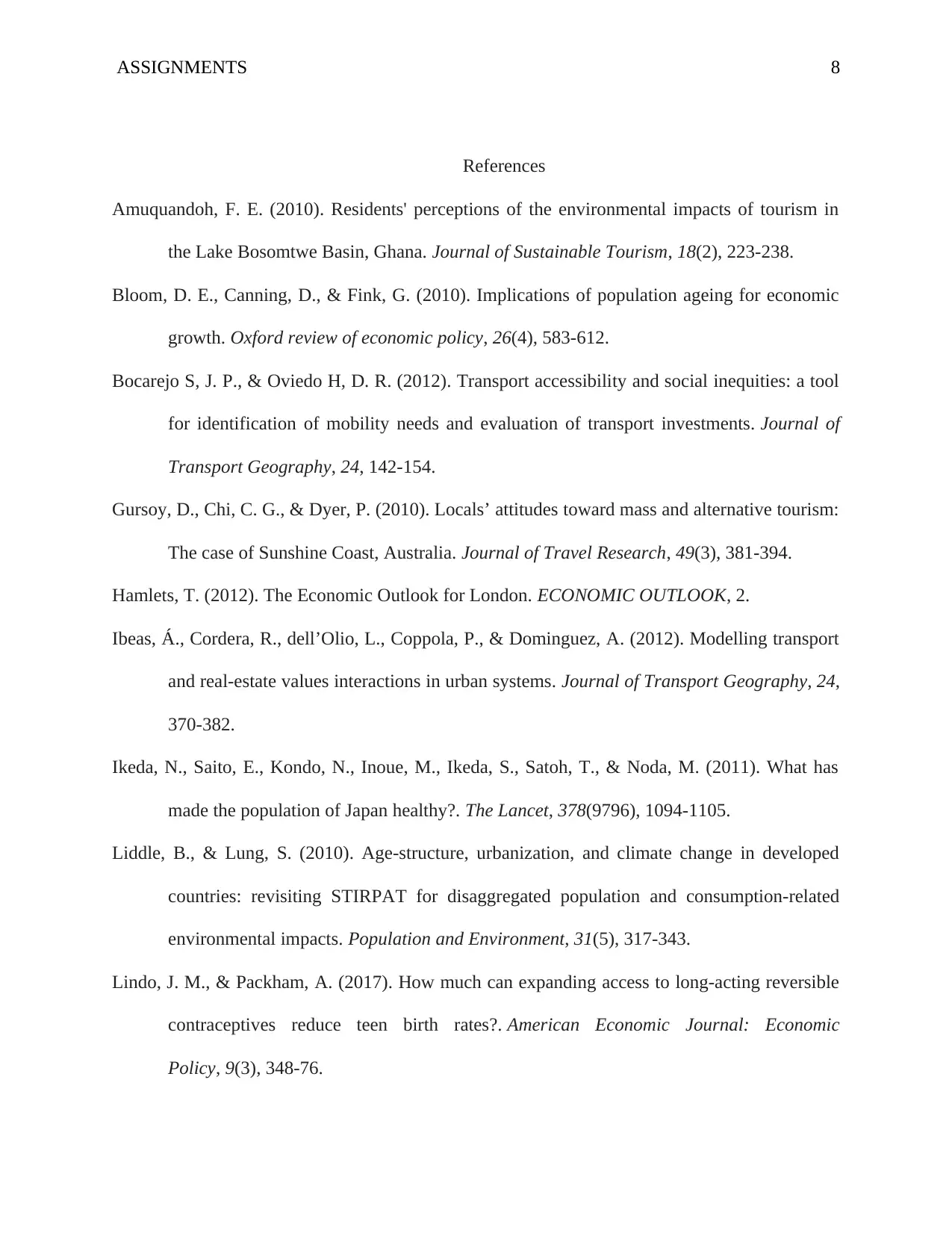
ASSIGNMENTS 8
References
Amuquandoh, F. E. (2010). Residents' perceptions of the environmental impacts of tourism in
the Lake Bosomtwe Basin, Ghana. Journal of Sustainable Tourism, 18(2), 223-238.
Bloom, D. E., Canning, D., & Fink, G. (2010). Implications of population ageing for economic
growth. Oxford review of economic policy, 26(4), 583-612.
Bocarejo S, J. P., & Oviedo H, D. R. (2012). Transport accessibility and social inequities: a tool
for identification of mobility needs and evaluation of transport investments. Journal of
Transport Geography, 24, 142-154.
Gursoy, D., Chi, C. G., & Dyer, P. (2010). Locals’ attitudes toward mass and alternative tourism:
The case of Sunshine Coast, Australia. Journal of Travel Research, 49(3), 381-394.
Hamlets, T. (2012). The Economic Outlook for London. ECONOMIC OUTLOOK, 2.
Ibeas, Á., Cordera, R., dell’Olio, L., Coppola, P., & Dominguez, A. (2012). Modelling transport
and real-estate values interactions in urban systems. Journal of Transport Geography, 24,
370-382.
Ikeda, N., Saito, E., Kondo, N., Inoue, M., Ikeda, S., Satoh, T., & Noda, M. (2011). What has
made the population of Japan healthy?. The Lancet, 378(9796), 1094-1105.
Liddle, B., & Lung, S. (2010). Age-structure, urbanization, and climate change in developed
countries: revisiting STIRPAT for disaggregated population and consumption-related
environmental impacts. Population and Environment, 31(5), 317-343.
Lindo, J. M., & Packham, A. (2017). How much can expanding access to long-acting reversible
contraceptives reduce teen birth rates?. American Economic Journal: Economic
Policy, 9(3), 348-76.
References
Amuquandoh, F. E. (2010). Residents' perceptions of the environmental impacts of tourism in
the Lake Bosomtwe Basin, Ghana. Journal of Sustainable Tourism, 18(2), 223-238.
Bloom, D. E., Canning, D., & Fink, G. (2010). Implications of population ageing for economic
growth. Oxford review of economic policy, 26(4), 583-612.
Bocarejo S, J. P., & Oviedo H, D. R. (2012). Transport accessibility and social inequities: a tool
for identification of mobility needs and evaluation of transport investments. Journal of
Transport Geography, 24, 142-154.
Gursoy, D., Chi, C. G., & Dyer, P. (2010). Locals’ attitudes toward mass and alternative tourism:
The case of Sunshine Coast, Australia. Journal of Travel Research, 49(3), 381-394.
Hamlets, T. (2012). The Economic Outlook for London. ECONOMIC OUTLOOK, 2.
Ibeas, Á., Cordera, R., dell’Olio, L., Coppola, P., & Dominguez, A. (2012). Modelling transport
and real-estate values interactions in urban systems. Journal of Transport Geography, 24,
370-382.
Ikeda, N., Saito, E., Kondo, N., Inoue, M., Ikeda, S., Satoh, T., & Noda, M. (2011). What has
made the population of Japan healthy?. The Lancet, 378(9796), 1094-1105.
Liddle, B., & Lung, S. (2010). Age-structure, urbanization, and climate change in developed
countries: revisiting STIRPAT for disaggregated population and consumption-related
environmental impacts. Population and Environment, 31(5), 317-343.
Lindo, J. M., & Packham, A. (2017). How much can expanding access to long-acting reversible
contraceptives reduce teen birth rates?. American Economic Journal: Economic
Policy, 9(3), 348-76.
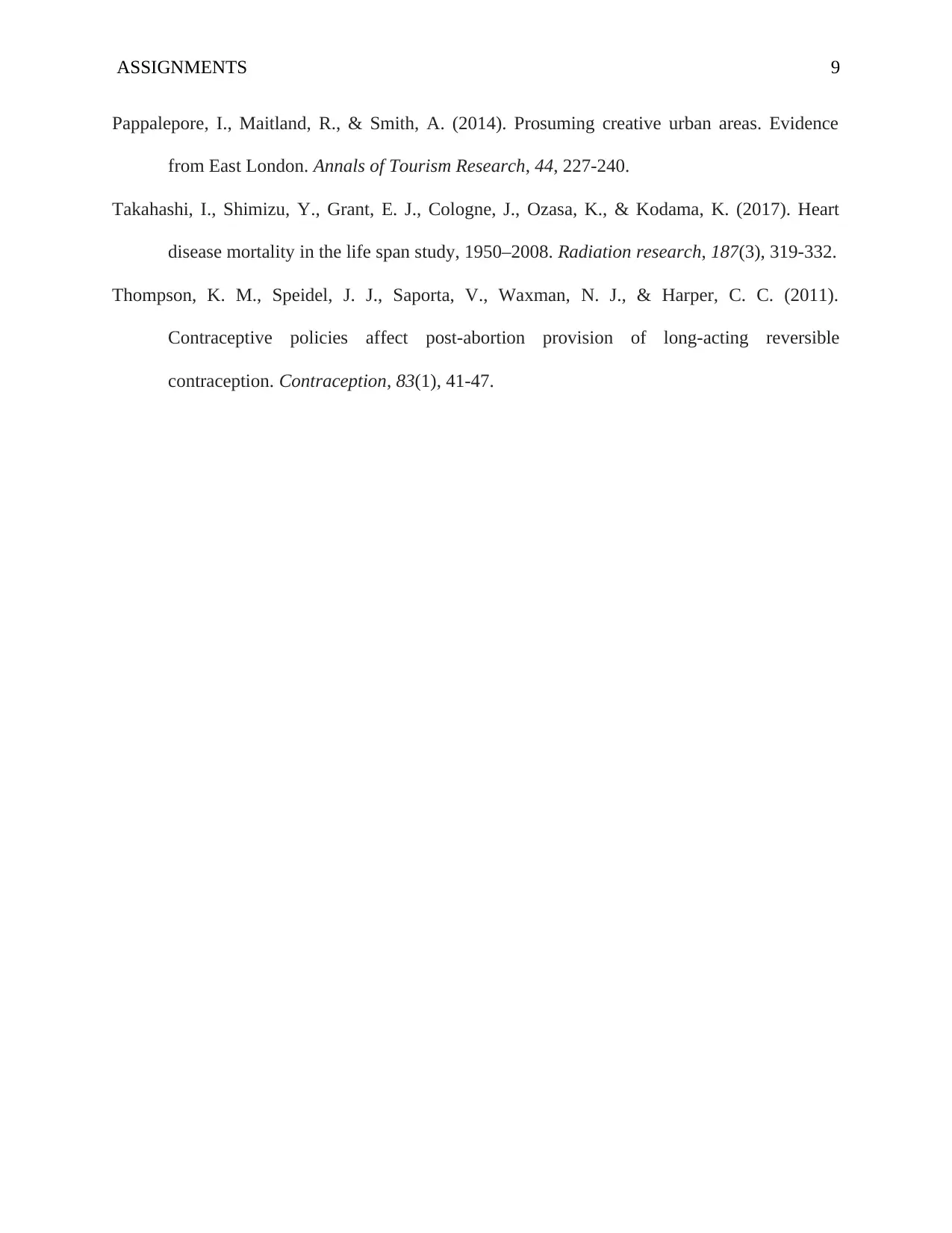
ASSIGNMENTS 9
Pappalepore, I., Maitland, R., & Smith, A. (2014). Prosuming creative urban areas. Evidence
from East London. Annals of Tourism Research, 44, 227-240.
Takahashi, I., Shimizu, Y., Grant, E. J., Cologne, J., Ozasa, K., & Kodama, K. (2017). Heart
disease mortality in the life span study, 1950–2008. Radiation research, 187(3), 319-332.
Thompson, K. M., Speidel, J. J., Saporta, V., Waxman, N. J., & Harper, C. C. (2011).
Contraceptive policies affect post-abortion provision of long-acting reversible
contraception. Contraception, 83(1), 41-47.
Pappalepore, I., Maitland, R., & Smith, A. (2014). Prosuming creative urban areas. Evidence
from East London. Annals of Tourism Research, 44, 227-240.
Takahashi, I., Shimizu, Y., Grant, E. J., Cologne, J., Ozasa, K., & Kodama, K. (2017). Heart
disease mortality in the life span study, 1950–2008. Radiation research, 187(3), 319-332.
Thompson, K. M., Speidel, J. J., Saporta, V., Waxman, N. J., & Harper, C. C. (2011).
Contraceptive policies affect post-abortion provision of long-acting reversible
contraception. Contraception, 83(1), 41-47.
⊘ This is a preview!⊘
Do you want full access?
Subscribe today to unlock all pages.

Trusted by 1+ million students worldwide
1 out of 9
Related Documents
Your All-in-One AI-Powered Toolkit for Academic Success.
+13062052269
info@desklib.com
Available 24*7 on WhatsApp / Email
![[object Object]](/_next/static/media/star-bottom.7253800d.svg)
Unlock your academic potential
Copyright © 2020–2025 A2Z Services. All Rights Reserved. Developed and managed by ZUCOL.





